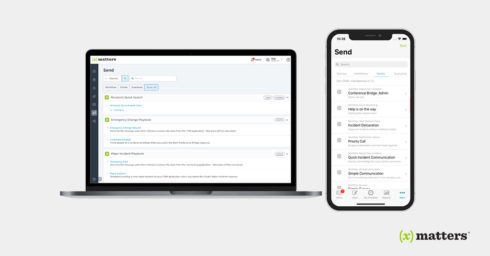
xMatters has announced new capabilities designed to help teams respond faster to incidents. According to the company, its data-driven DevOps approach helps DevOps, SRE and operations teams collaborate through the xMatters Incident Console, Slack, Microsoft Teams and Zoom. Other updates include a new “Incidents by Severity” widget, and new capabilities in its messaging user interfaces so teams can communicate better and react quickly to time-sensitive issues.
“Competitive companies don’t want to simply reduce incidents and keep their services running, they want to do so while simultaneously releasing exciting products that customers will love. Traditionally, this has been a hard balance to strike—the faster and more innovative teams try to be, the more likely they are to break existing services or overlook factors that impact the customer experience in production,” said Doug Peete, chief product officer at xMatters. “Without the proper tools to support their desired velocity, development and operations teams are hamstrung dealing with technical issues that divert time and resources from core product initiatives. We’re excited to launch new xMatters features that automate and simplify the toolchains our customers use to manage the growing network of microservices underpinning every modern business, while empowering effective cross-team communication and collaboration.”
SolarWinds unveils new APM Integrated Experience
The new APM Integrated Experience provides consolidated access to metrics, traces, logs and user experience.
“As the personas using APM continue to expand to include developers, support teams, product managers, infrastructure teams, and more, there is a need for an APM solution that caters to these broader audiences and brings together all the data necessary to understand and validate application performance,” said Denny LeCompte, senior vice president, products of SolarWinds. “Through the APM Integrated Experience, we are maximizing customers’ observability and ease of use. This convergence reflects our commitments to making tech pros’ lives easier and to broadening APM access for tech pros everywhere.”
Key features include a high-level view of changes and issues, dashboards, code-level APM data, advanced searching capabilities, ability to explore and alert on metrics, real-user monitoring and synthetic monitoring.
Atlassian acquires visualization and analytics solution provider Chartio
The new acquisition will help Atlassian expand data visualization capabilities across all its products.
“Atlassian products are home to a treasure trove of data, and our goal is to unleash the power of this data so our customers can go beyond out-of-the-box reports and truly customize analytics to meet the needs of their organization. Chartio is an important component of this vision as it will serve as our new analytics and data visualization engine across our products, starting with the Jira family,” Zoe Ghani, head of product at Atlassian, wrote in a post.
Google Cloud and MongoDB on application modernization
The two companies are expanding their partnership to provide deeper integration between Google Cloud products and MongoDB’s cloud database. According to the companies, this will help accelerate application modernization.
“With this expanded partnership, MongoDB is enabling developers to integrate Atlas with Google Cloud products, including Pub/Sub, BigQuery, Dataproc, Dataflow, Cloud Run, App Engine, Cloud Functions, Google Kubernetes Engine (GKE), and Tensorflow. Additionally, Google Cloud’s mainframe modernization solutions now support MongoDB Atlas and help customers convert legacy COBOL code on mainframes into modern Java-based applications built on MongoDB. Together, G4 and MongoDB Atlas accelerate the modernization and migration process for organizations moving their business-critical workloads to the cloud,” according to the companies’ announcement.






